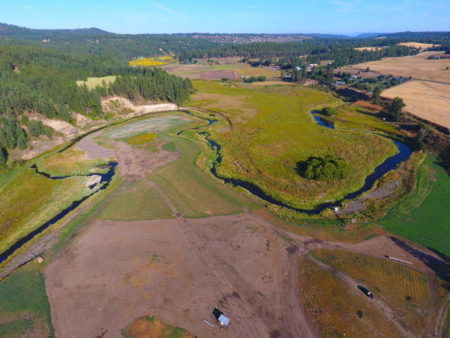Hangman Creek project shows the way for water quality and streambank restoration best practices

As we stand by Hangman Creek in the still summer air, the heat is high and the water barely moving. The stream’s vertical banks offer an innocuous natural charm, adding texture to the landscape and a postcard feel to the farm that has welcomed us.
Why, then, has the Spokane Conservation District (SCD) chosen this location to remove over 12,000 yards of native soils, reshaped vertical walls into gentle slopes, and installed erosion fabric, woody debris and coarse rock materials along 3,000 feet of streambank? “It’s about reducing erosion and sediment loading into the creek,” said Walt Edelen, SCD’s Water Resources Program Manager.
This one-minute video with drone footage shows the dramatic changes taking place with this stewardship project.
Come back in the spring, says Edelen, and the water will be ripping through anywhere between 6,000 and 20,000 cubic feet per second (cfs). Currently it’s at about 20 cfs. The twists and turns of the creek offer ample opportunities for the confined water to beat against the banks, causing erosion and turning the creek into a chocolate milkshake that brings thousands of tons of sediment downstream each year. The sediment loading and reduced oxygen place the survival of fish, including native Redband Trout, at risk and contribute to poor water quality that effect habitat as far downstream as Lake Spokane.
Called the “River Mile 17 Project,” SCD’s Senior Project Leader Dan Ross explains the bio-engineering approach used for stream re-construction. “We’re slowing the water down and reducing erosion by changing the bank slope, replanting the area with native species, and using the flood plain area to naturally receive excess water rushing downstream from the spring freshet.”
To accomplish the task, over 10,000 native willows, trees and shrubs were installed along the 3,000-foot project area where the banks were reshaped. In addition, an additional 35-foot commodity buffer was installed to offer further protection. Woody debris and other techniques were used to stabilize the streambank as the vegetation takes hold. And because the landowner has a water right, over 3,000 feet of irrigation was installed to support the new vegetation.
Said Edelen, “If we could do 20 – 30 more projects like this, Hangman Creek’s water quality and conditions for fish would greatly improve.”
But finding projects is more than just about finding funding. Hangman Creek is bordered by fertile, privately owned parcels and farmlands. Indeed, some farming and governmental programs from previous generations contributed to the challenges of today by straightening parts of the creek and disconnecting it from its’ floodplains. “The bottom line back then,” said Edelen, “was to put as much farmland into production as possible. This was the natural progression of settlement in the watershed.”
A critical part of SCD’s outreach is to offer farmers and landowners both a streambank restoration and a commodity buffer option. With the commodity buffer, the farmer is annually compensated for the lost value of not planting in the protected area. In addition to projects like River Mile 17, buffers (generally a 25 – 75-foot strip of land abutting the streambank) are used to hold back sediment and nutrient loading that wash down from the upland soil.
Projects like this give people confidence that restoration does not come at a cost to agricultural viability and benefits the environment. Finding this stewardship sweet spot is a must because without willing landowners, the work can not be done. Well over 90% of the lands abutting Hangman Creek, for instance, are privately owned.
In this case, seeing is believing. Edelen and Ross point downstream to a couple of landowners who have seen this project and are now interested in doing something similar.
Long-term, the SCD is teaming with other stakeholders and technical assistance providers to amp up efforts in Hangman Creek and other Spokane County waterways with similar issues. Edelen points to federal programs like USDA’s Regional Conservation Partnership Program, state efforts like the Voluntary Stewardship Program and water quality grants as providing the resources needed to make a long-term difference.
Said Edelen “We’re reaching out to landowners and farmers every day to get them involved and engaged. Our pitch is that agriculture and a healthy stream can and should be able to co-exist side by side. The River Mile 17 Project shows how willing landowners, strong partnerships and funding can come together to get the job done.”
